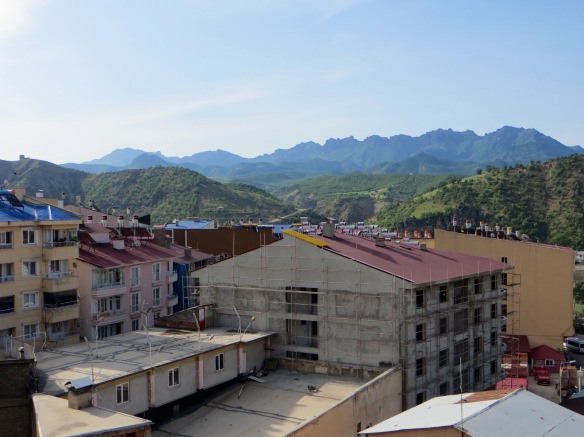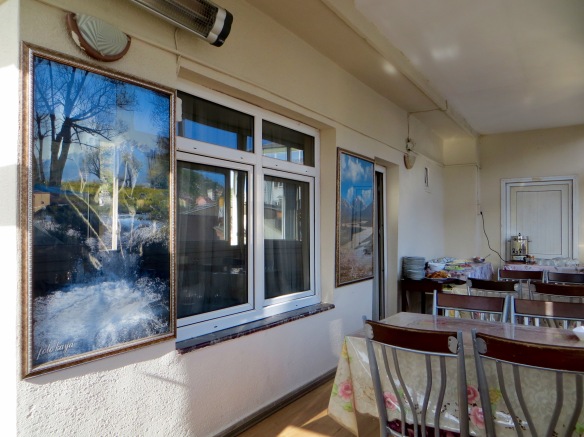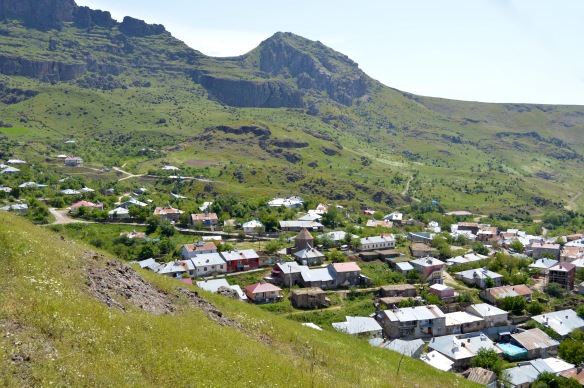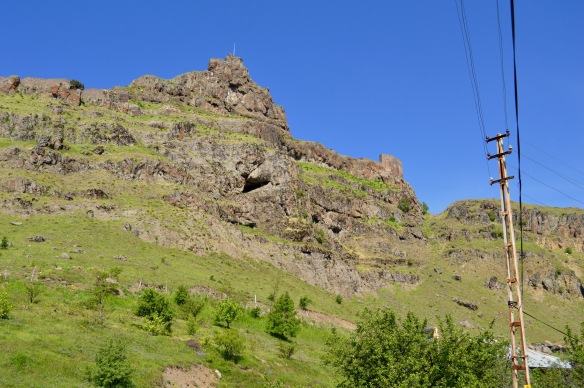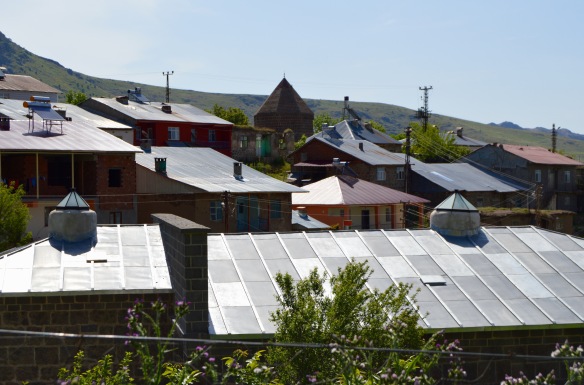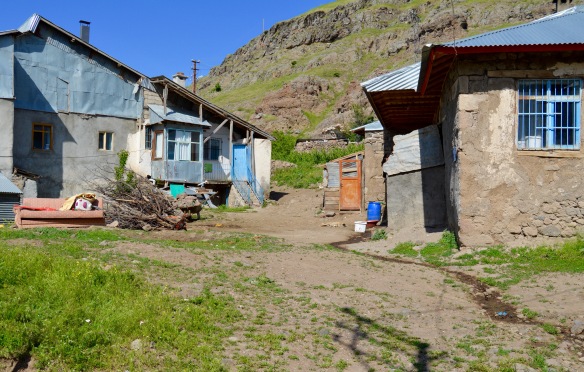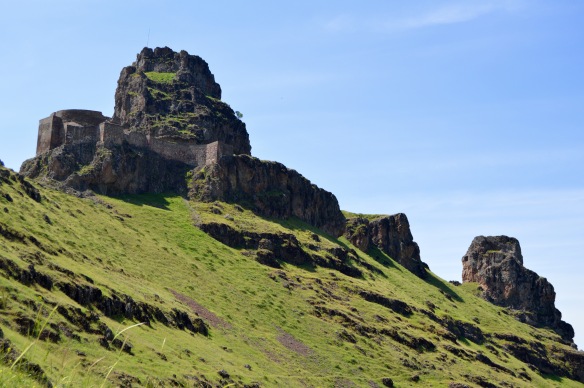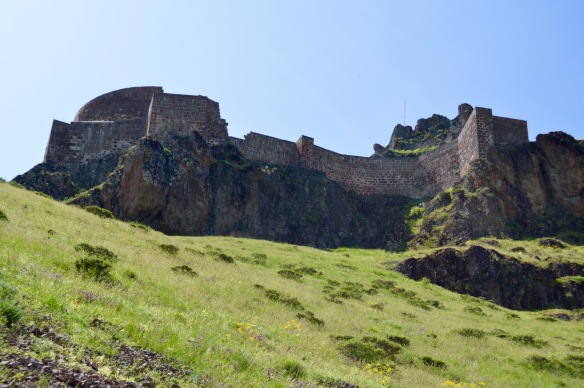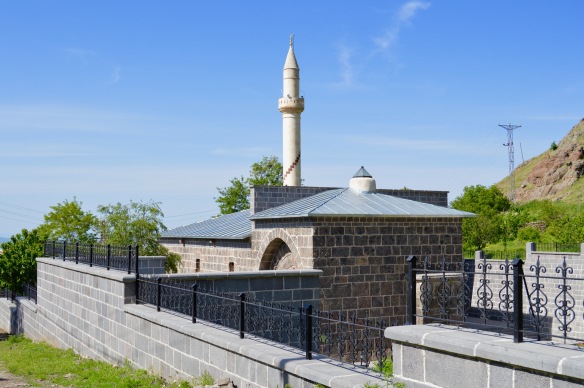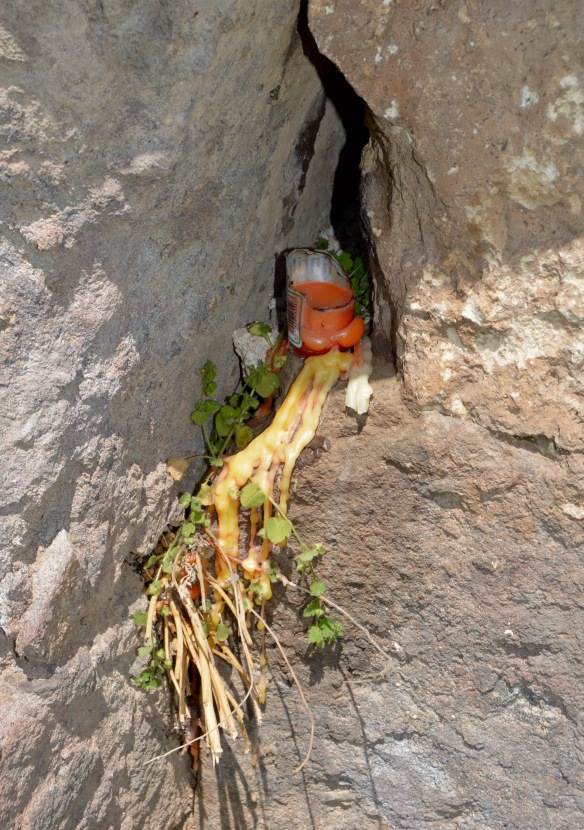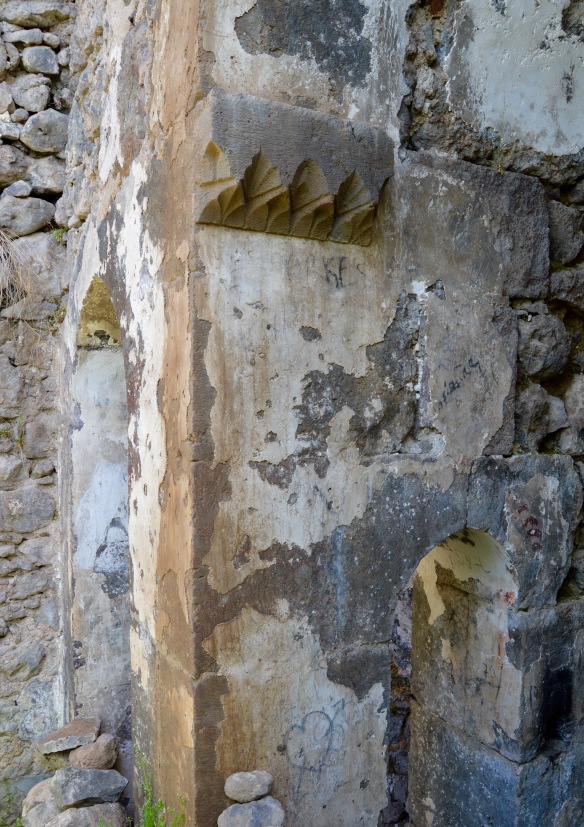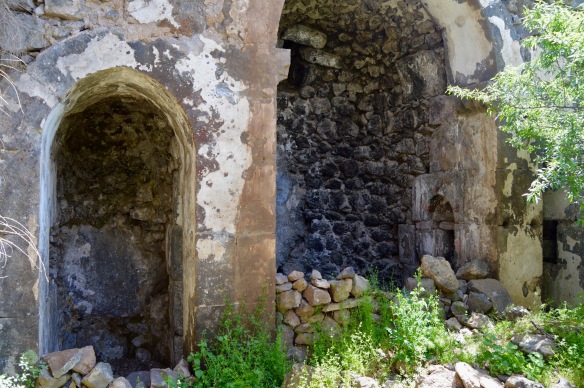I left Ulu Camii and the Hospital to walk through the pretty residential areas to the south. Although some old buildings had been demolished so that modern houses and small apartment blocks could fill a few of the gaps, a lot of old houses survived. Most old houses were timber-framed and some had overhanging upper storeys supported on wooden corbels. There were also some houses made with stone, but these were fewer in number and more likely to be abandoned by their owners. Most old houses had gardens beside them. Near where the market had set up for the day was a large cemetery containing many old graves and small tombs. Many of the graves had irises in or beside them and they were in bloom. Where the irises clustered together en masse they looked very impressive.

View toward the citadel, Divrigi.

Divrigi.

Divrigi.

Divrigi.

The cemetery, Divrigi.

The cemetery, Divrigi.
I saw three turbes as I walked around, the ones for Sitte Melik, Kamareddin and Kemankes. All three had octagonal ground plans and pyramid roofs, and were austere in appearance externally. On the western edge of the commercial heart of Divrigi was a very large hamam still in daily use. The hamam had an impressive roof broken up by domes. Holes had been pierced into the domes and filled with glass to allow natural light to access the interior. Immediately beside the hamam was a carefully restored bridge that in the old days would have been one of the two or three main routes into the centre of Divrigi. The bridge crossed a narrow river, which no doubt supplied the hamam with its water in the past.

The hamam and citadel, Divrigi.

The hamam, Divrigi.

A turbe, Divrigi.
At the end of my walk, I had a look around the excellent and very extensive market. There were at least a hundred stalls on an irregularly shaped open space not far from the town’s small but attractive pazar, which was no more than a few streets running at right angles to one another overlooked by shops, offices, tea houses, lokantas and workshops for craftsmen. The market was dominated by stalls selling food such as fruit, vegetables, cheese, olives, honey, sweets and bread, but other stalls specialised in clothes, shoes, items for the kitchen, hardware, tools, goods made with plastic, cheap electrical gadgets, live hens and plants for the garden. It was very crowded and remained so for most of the day. Many minibuses had brought people from villages and small towns in the surrounding area and most would not return until about four or five o’clock. Adding to the spectacle and the noise were members of the political parties who were out in force trying to persuade people to vote for them. Vans with loudspeakers toured the streets playing music, speeches or irritating jingles. Outside the party political headquarters, men gave out leaflets or verbal information about the policies their leaders intended to implement if they formed the next government. It was the perfect day to be in Divrigi. Wednesdays must knock spots off all the other days of the week, especially if a general election is soon taking place.
One small thing I liked about Divrigi was that quite a lot of cesmes survived and they still dispensed water. As I walked around, I filled my bottle three times thinking what an asset they must be when the temperatures are at their highest from the beginning of July to the middle of September.
In the market, I bought a half kilo of sweet but juicy and ready-to-eat strawberries of dark red colour for only 2TL, then walked back to the hotel. Not far from the Belediye was a bufe that sold beer for 5.1TL, which was not a bad price, all things considered, especially given the good exchange rate working in favour of people with pounds sterling. I thought of how enjoyable the walk had been, not least because of the cesmes just mentioned from which chilled water never failed to pour. But I had also enjoyed the chats with people I had met: a young female professional photographer at Ulu Camii; student teachers training to work in religious schools; couples, some with children, visiting Divrigi from cities such as Bursa, Izmir and Istanbul; a bus driver very tired during a long day’s shift; and a tour guide from Ankara visiting new places on his own to offer unusual destinations to his tour groups. Divrigi seemed to have a large Turkish and Sunni population. The latter was apparent because most women walked around with headscarves arranged to completely cover their hair and ears. The presence of so many headscarves in an urban environment meant that chats with women were infrequent and very brief, the photographer excepted. Because the photographer came from Istanbul and was a thoroughly modern woman, chat with an unknown male was of no consequence to her. And, because I was old enough to be her grandfather…

The market, Divrigi.
At 3.00pm, I sat on my balcony writing up notes about the day so far. I ate a few of the strawberries with the last of some chocolate, the latter a parting gift from Hilary, and the remains of a packet of Lidl’s crisps, which had survived the train journey from Darlington to Manchester Airport at the start of the trip. Lots of swifts circled just to the south of the hotel and, later that evening, I discovered why. They had built nests in many of the balconies on the top floor of the hotel, the floor above mine. However, one swift flew too close to the ground. A cat scuttled across the patio with the bird struggling in its mouth.
About an hour later, I left the hotel and turned right to examine a nearby park run by the Belediye. From the park were excellent views of the citadel, the railway station, the hills and mountains to the north and the river far below. A few children enjoyed the facilities in a large playground. Young couples had come to flirt on benches and drink tea or soft drinks in a quiet tea garden. Suddenly the horn of a diesel locomotive sounded from the railway track beside the river and a freight train rattled toward Divrigi station from Kemah and Ilic. Dark clouds gathered in the sky and a rumble of thunder suggested there might be some rain, just as in Arapgir the evening before.

The park and playground, Divrigi.
I walked into the centre of the town to look around the market, watch two men in their workshops in the pazar repair metal cooking utensils, examine the large hamam with its many domes and the restored bridge beside it, take photos of some old houses and chat with a few men outside the regional headquarters of the MHP. I spoke in particular with Mustafa, a doctor aged about 40 with long hair who was campaigning on behalf of the party. However, most noise was generated at the AKP headquarters, but whether such noise was attracting or repelling voters I could not say. A picture of Erdogan looking statesmanlike had been transferred to a rectangle of material larger than a bed sheet and it flapped in the gentle breeze. The AKP would probably secure a high vote in Divrigi, but I based this assessment only on the appearance of many of the local people. Conventional Sunni piety seemed to prevail among a majority of men and women of voting age. Hajis’ beards and women’s headscarves were very common.

The hamam and restored bridge, Divrigi.

The MHP headquarters, Divrigi.

The pazar, Divrigi.

The pazar, Divrigi.
I called at a branch of the BIM supermarket chain for a refreshing ayran that was mild and creamy with a hint of salt and sourness, then stopped at a bakery in the pazar for a flat loaf of bread just out of the wood-fired oven. The bread had a brown but soft crust with parallel ridges just like a ploughed field. I ate some of the bread as I walked along and, while doing so, decided not to have a sit-down meal to end the day. Instead, I would finish the remaining strawberries with what was left of the bread. It was good not to stick with too rigid a routine when it came to food.
From the park beside the hotel, the railway station and its associated clutter looked so interesting that I went to look around the area more closely. Only two passenger trains passed through Divrigi each way every day, but the station was kept in very good condition (one of the trains was due in about an hour’s time and two passengers were waiting for it). There was a rarely used bufe on the platform and, some distance from there, a small locomotive works where repairs could be undertaken. Freight trucks, abandoned carriages and old and new locomotives occupied a few sidings, and near the locomotive works was a turntable. A few of the locomotives and carriages looked worthy of sending to a museum. Small apartment blocks between the station and the locomotive works had been built a few decades ago to accommodate families with at least one adult working on the railway, but it was doubtful that all the apartments were lived in by such families now. Although some routes in the west of the country were now high speed and enjoyed a lot of passenger traffic carried in modern trains, most routes east of Ankara, the capital, were starved of resources and could not compete with transport on the rapidly improving road network, although there were indications that some routes in the east will eventually be up-graded. I hope they are up-graded. I have enjoyed every encounter I have had with Turkey’s rail network and one year I will travel some of the routes again.

The railway station, Divrigi.

The railway, Divrigi.
I walked along a siding where grass and wild flowers grew between the wooden sleepers. A few low wagons had been parked on the siding and each wagon carried lots of new concrete sleepers. Here was evidence that some up-grading would soon take place in the region.
I returned to the hotel and sat on my balcony as I ate the last of the strawberries, the bread and an apricot, the latter a gift provided by someone in the market. It was now about 6.45pm and on the patio about eight of the tables were occupied, some by groups of men, some by groups of young women and some by couples. One large table was taken by a Turkish family and another by a French one. Most people had ordered drinks. Beer was popular with males and females, but food was available from the kitchen. This was too good an opportunity to miss, so I went downstairs, sat at one of the tables, ordered the first of two beers and wrote a few notes as I enjoyed the excellent views of the citadel, the ruined church, one of the town’s octagonal turbes, the nearby hills and mountains, a short stretch of railway track, the swifts flying overhead and the views toward the centre of Divrigi. It proved a very pleasant end to a very enjoyable day.

The citadel and Armenian church, Divrigi.
I chatted with the French family. The mother and father were in their late thirties, their daughter was 13 and their son was 11. The children had been taken out of school to have an adventure they were unlikely to ever forget; they were touring eastern Turkey, Georgia and Armenia on their bikes. The family had flown to Ankara and, after one night in the capital, had caught a train to Sivas. After three days touring the area around Sivas, they returned to the city and travelled by train to Divrigi where they were staying for another three nights. Their next destination was Kars from where they intended to cycle to and from the ruined medieval Armenian city of Ani.
“How will you get to Armenia?” I asked. “My understanding is that all border crossings between Turkey and Armenia are closed, to foreigners at least.”
“Yes, that is also our information,” said the mother. “We will go by road from Turkey to Georgia and enter Armenia from Georgia. After seeing some of Armenia, we will return to Turkey via Georgia. It is sad we cannot go directly from Turkey to Armenia, but history and politics are so often problems for many countries and their relations with their neighbours.”
The problem of transit arrangements between Turkey and Armenia was rendered even more insane because growing numbers of Armenia’s citizens were travelling to Turkey to make sense of their family history. Moreover, it was said by some analysts that no fewer than 100,000 Armenian guestworkers now lived and worked in Turkey because the Turkish economy was much more buoyant than the one in Armenia (however, some sources put the actual figure for such guestworkers as low as 10,000. A figure of 50,000 may be more accurate).
The Belediye Hotel was a reminder of the days before economic liberalisation, the dismantling of the state monopolies and the rise of the AKP. A lot of the 1970s and early 1980s persisted in the appearance of the building and the facilities it provided. With its overwhelmingly male-friendly character and complete indifference to religion, the hotel encouraged the idea that Ataturk’s commitments to Turkish nationalism, secularism and public funding for and state management of economic development remained uncompromised. But uncompromised they no longer were because, in the late 1980s in particular, what had come to be known as Kemalism was subjected to long-overdue critical appraisal. However, not everything associated with Kemalism was misguided and, at Divrigi’s Belediye Hotel, I was brought face-to-face with some of its benefits (although the hotel’s male-friendly character cried out for the civilising effect of a female-friendly makeover).
Even the hotel manager looked a left-over from the increasingly remote and discredited era when the secular forces in Turkey ruled the roost. He was overweight, wore a denim shirt and trousers, had thick black hair that looked like a wig and boasted a moustache resembling a large black slug. He lacked a beard because its existence would have implied sympathy with Islam. His somewhat raffish and dissolute appearance reminded me of the very popular 1970s and 1980s male singers of Kurdish origin who could not say they were Kurds because, at the time, Kurds did not officially exist in Turkey. True, the Kurdish male singers of old took more care with their appearance than the hotel manager, but they could afford to because they were rolling in money.
The westbound evening passenger train went by with eight carriages about five minutes ahead of schedule.
Every time I visit Turkey in general and eastern Turkey in particular I think the bubble will burst and I will have no further desire to return, other than to see a few people who have been far more generous with their hospitality than I ever deserved. The Turkey that first got me so excited has largely disappeared due to growing prosperity, improved communications and humankind’s inclination to suppress the things that make us different, but, especially in the villages and small towns where traditional ways of doing things persist the longest, I still get a thrill when I encounter something unexpected or that challenges my preconceived ideas about the country and its people. Also, I now realise that differences will always exist because the process of assimilation can never be total or complete, which is something that fills me with delight because, in Turkey as in so many other nation states, I am drawn to minorities that bravely sustain their distinctive identity in often hostile environments. It always puzzles me why majority populations feel so threatened by minorities that seek merely to preserve from the past some of the things that make them different. Provided such things do not conflict with fundamental human rights, what is the problem? Diversity should be celebrated instead of undermined.

Divrigi.
P.S. Back home on the internet, I accessed “Chronological Index: the extermination of Ottoman Armenians by the Young Turk regime (1915-1916)” on the “Online Encyclopedia of Mass Violence”. The index includes this brief entry about Divrigi:
May 1915, kaza of Divrigi (province of Sıvas). After the arrest of the local Armenian elite, a second wave of arrests is organised on the merchants and artisans of Divrigi, upon which underage adolescents, comprising some 200 individuals, are mobilised. Submitted to torture for several days, these men are finally brought to the outskirts of the town, shackled and forced to march to the gorges of Deren Dere, where they are assassinated with axes (Kevorkian, “The Armenian Genocide”, 2006: 551-2).
The index also describes massacres or deportations that took place in Cemisgezek, Cungus, Diyarbakir, Ergani, Erzincan, Harput, Palu, Pulumur and Sebinkarahisar, all of which I visited during the trip. It also describes massacres or deportations that took place in Adana, Afyon, Aksehir, Amasya, Ankara, Bayburt, Birecik, Bitlis, Bolu, Burdur, Bursa, Edirne, Egil, Erzurum, Eskisehir (the large city in the west of modern Turkey, not the small settlement near Arapgir), Gaziantep, Istanbul, Izmir, Izmit, Kangal, Karaman, Kastamonu, Kayseri, Konya, Malatya, Manisa, Mardin, Mus, Nigde, Odemis, Samsun, Sason, Siirt, Silvan, Sivas, Talas, Tercan, Tokat, Trabzon and Yozgat. These are all places I had visited during earlier trips. I was shocked to see how often the small town of Kigi is mentioned, a place not far from Bingol that I did not have the time to visit. Buried away in the index are passing references to the massacre of Syriac Orthodox and Chaldean Christians in places such as Cizre, Midyat and Nusaybin, yet more settlements I had visited in the past. The full enormity of the genocide directed against the Armenians, and the crimes against humanity perpetrated against the Syriac Orthodox and Chaldean Christians, impressed themselves in a manner more obvious than ever before.















